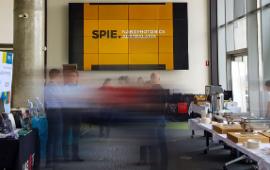International SPIE NanoPhotonics forum takes over Swinburne

In Summary
- Swinburne hosts SPIE NanoPhotonics Australasia forum
- The forum explores the latest in nanophotonics technologies
Celebrating and exploring the latest in nanophotonics technologies, this week the SPIE NanoPhotonics Australasia forum took over Swinburne as it looked to the future.
The leading multidisciplinary forum focuses on research that has enabled promising new nanophotonic technologies and applications across many fields, including photonics, energy, security, information, and medicine.
Speaking at the opening of the forum, Swinburne Vice-Chancellor Associate Professor Linda Kristjanson AO said that the conference was a chance for leading researchers at Swinburne and abroad to connect and share innovative work that is happening all over the world.
“Swinburne’s Centre for Micro-Photonics is an internationally leading centre in biophotonics and nanophotonics research,” she says.
“It provides a world-class laboratory for training Australian and international students, while conducting research that makes a real-world impact.”
“The breakthroughs that come out of this centre continue to impress and inspire me.”
Swinburne looking to the future
Recent achievements from Swinburne in the areas discussed at SPIE NanoPhotonics Australasia include:
Eureka prize winners
Professor Elena Ivanova and Professor Saulius Juodkazis won the prestigious UNSW Eureka Prize for Scientific Research for their work in nanophotonics.
In a novel approach to the growing epidemic of antibiotic-resistant bacteria, the pair studied the wings of cicadas and dragonflies to determine how their surfaces resisted pathogens.
Through their research, they discovered that nano-pillars on the surface of the cicada and dragonfly wings provided physical resistance to the bacteria.
Their research could offer scientists worldwide a new weapon in the fight against antibiotic-resistant bacteria.
BEST battery
Professor Baohua Jia and Dr Han Lin are leading a team in developing the Bolt Electricity Storage Technology (BEST) battery.
The battery is a graphene oxide-based supercapacitor offering high performance and low-cost energy storage and has the potential to make chemical batteries a thing of the past.
Quantum technology
As part of an international team of researchers, Professor David Moss has taken quantum technology one step closer to moving out to the lab, and into the palm of consumers.
The team made a major breakthrough this year in developing a new concept for the generation and control of complex quantum states on microchips and in optical fibre technology. This technology could ultimately be used in home computers, laptops and smartphones.
SPIE NanoPhotonics Australasia was held 10 to 13 December 2017

